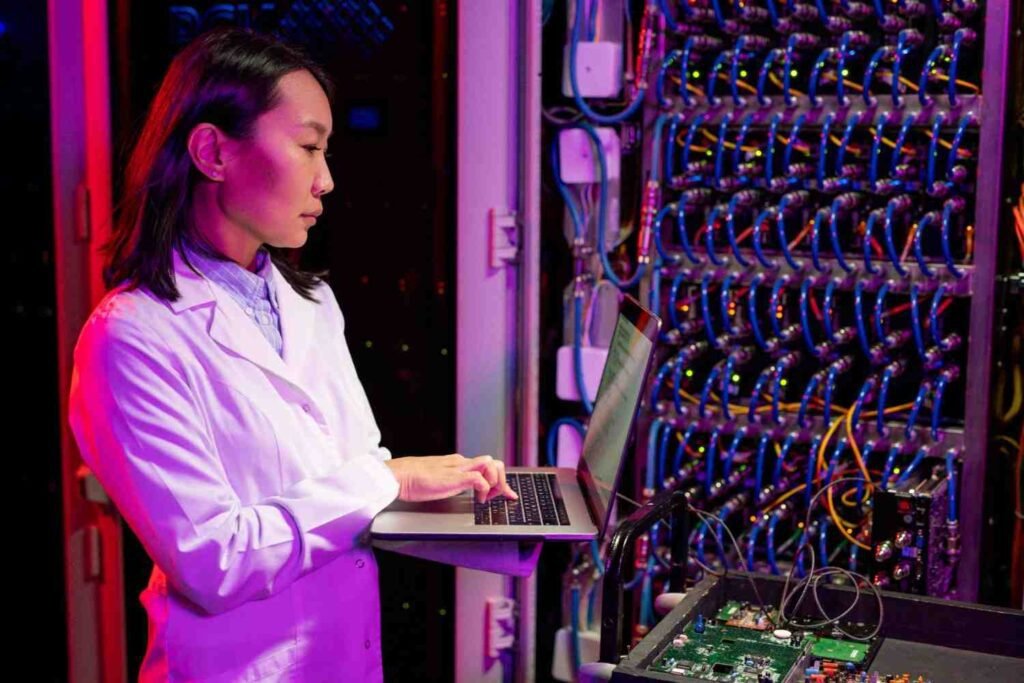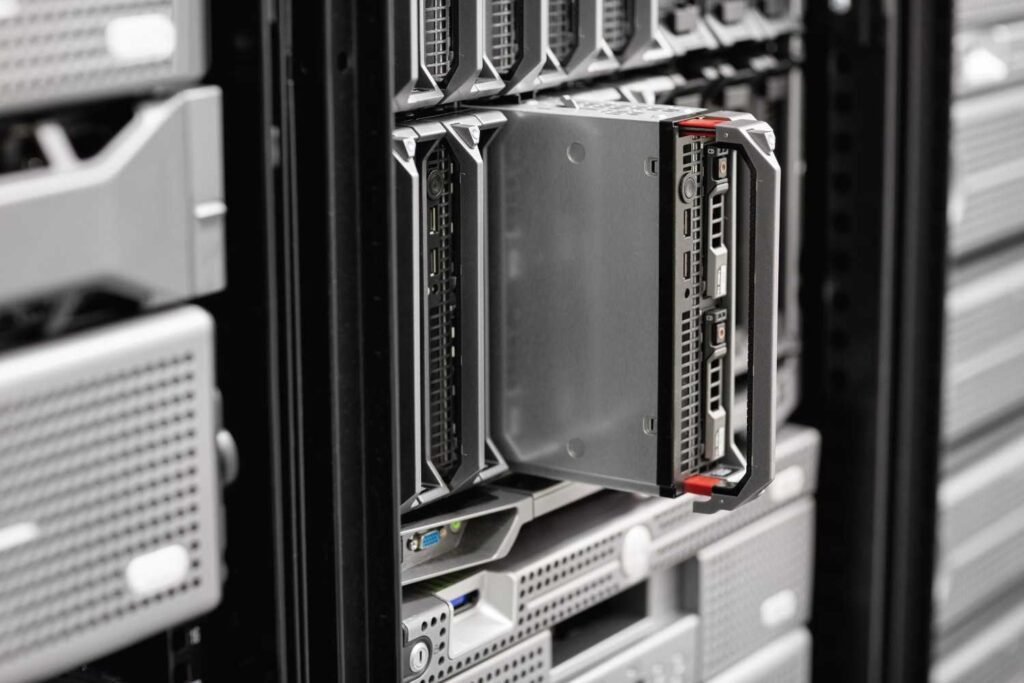Top 10 Latest Technologies in Software Industry
The software industry is always changing with the latest technologies in the software industry that help improve how we live and work. Many of these latest technologies in the software industry make our devices smarter and help us do tasks faster. This guide will look at ten of the most exciting and recent technologies in the software field. These tools and programs are making a big impact on everything from gaming to business operations. Let’s explore how these latest technologies in the software industry are shaping our future.

10: Machine Learning (ML) and Artificial Intelligence (AI)
ML and AI are important and are the latest technologies in the software industry. They are changing fields like healthcare and finance by helping with things like better diagnoses and finding fraud. They make work easier and encourage new ideas by quickly looking at a lot of data.
How it works:
AI works like human thinking, helping machines understand language and see patterns. ML is a part of AI that helps machines learn from data and get better over time without needing to be told how.

9: Blockchain Technology
Blockchain technology is one of the latest technologies in the software industry that changing how we share data and do transactions. It was first made for cryptocurrencies like Bitcoin, but now it is used in many areas like supply chain management, healthcare, and real estate. It helps provide a safe and clear way to record transactions.
How it works:
A blockchain is like a shared notebook that keeps track of transactions on many computers. This way, everyone can see the same information. Each block in the chain has a list of transactions and a special code that connects it to the block before it, making a timeline that cannot be changed. This system helps make things safer, lowers the chance of cheating, and makes everything more open. This makes it very important for businesses that want to earn customer and partner trust.
ALSO READ: 7 Latest Engineering Technology of 2024

8: Internet of Things (IoT)
The Internet of Things (IoT) is an important step forward in connecting devices, allowing regular objects to gather and share information online. The latest technologies in the software industry are changing many areas, like smart homes, healthcare, and transportation, by making it possible to monitor data in real time and automate tasks.
How it works:
IoT devices have sensors, software, and the ability to connect to the internet, which helps them talk to each other and send information to central systems. For example, in a smart home, devices like thermostats, lights, and security systems can be controlled from a smartphone app, making life easier and saving energy. The data these devices collect can also be studied to improve how they work, predict when they need repairs, and make the overall experience better, showing how important IoT is in the changing tech world.

7: Quantum Computing
Quantum computing is set to change how we use computers by using the special rules of quantum mechanics to work with information much faster than ever before. Unlike regular computers that use bits as the smallest piece of data, quantum computers use qubits, which can show and handle many different options at the same time. This makes quantum computing very strong for solving tricky problems in areas like security, material science, and finding the best solutions.
How it works:
- Quantum Phenomena: Quantum computers use superposition and entanglement.
- Superposition: Qubits can be in many states at once, which helps with working on several things simultaneously.
- Entanglement: Qubits are linked; the state of one qubit can instantly change another, no matter how far apart they are.
- Boosted Power: These features greatly increase computing power, allowing quantum computers to tackle tough problems that regular computers can’t.
- Industry Impact: The latest technologies in the software industry can lead to amazing discoveries in many different fields.

6: Virtual Reality (VR) and Augmented Reality (AR)
VR and AR are changing how we see and use digital stuff by creating fun environments for users. AR adds digital information to the real world, making what we see more interesting, while VR takes users to completely made-up places, giving cool experiences in fields like gaming, school, and training.
How it works:
Augmented Reality (AR) mixes digital things with the real world using gadgets like smartphones, making experiences better by showing helpful information. Virtual Reality (VR) makes whole new worlds using headsets, cutting off users from what’s around them. Both AR and VR are used in many fields, with AR helping customers see products better and VR giving engaging learning experiences. As AR and VR get better, they will greatly influence the future of interactive technology.

5: Containerization and Microservices
Containerization and microservices are modern ways to build software that help applications grow and work better. This method lets developers create apps as a group of small, separate services, each doing a specific job. Containerization packs these services with everything they need into portable containers, making it easy to run them in different places, from testing to real use.
How it works:
- Containers: Containers hold an app and what it needs to run, so it works the same everywhere. This solves the problem of “it works on my computer” because the setup stays the same no matter where the container is used.
- Microservices Architecture: Instead of making one big application, microservices let developers build apps as a set of small services that talk to each other using APIs. This way of working makes updates and scaling easier, as you can change or swap out one service without breaking the whole system.
- Benefits: Combining containerization and microservices makes teams faster, helps them use resources better, and allows ongoing updates. It also supports continuous integration and deployment, so teams can innovate and meet changing business needs more easily. Overall, this new way is changing how software is made, used, and looked after in the cloud-native world.
ALSO READ: 10 Best Tattoo Removal Technology in 2024

4: Low-Code Development Platforms
Low-code development platforms are changing how apps are made by letting people create software using easy visual tools and little coding. These platforms are for many types of users, from skilled developers to business workers, helping them build and launch apps faster while making it easier for those who aren’t tech experts.
How it works:
Low-code platforms make building apps simpler by allowing users to design them using drag-and-drop features, reuse templates, and link easily with other systems. They help teams work together better and let “citizen developers” pitch in without needing a lot of IT skills. This way of working is helping businesses change quickly, allowing them to meet the growing need for software efficiently.

3: DevOps and Continuous Integration/Continuous Deployment (CI/CD)
DevOps is a cultural and technical movement aimed at fostering collaboration between software development and IT operations teams to improve the speed and quality of software delivery. By integrating processes and tools, DevOps enables teams to automate and streamline the software development lifecycle. Continuous Integration (CI) and Continuous Deployment (CD) are key practices within DevOps, ensuring that code changes are frequently merged and deployed to production environments, thus enhancing the overall development workflow.
How it works:
- Continuous Integration (CI): This practice involves automatically testing and merging code changes into a shared repository several times a day. Automated testing helps identify bugs early, while version control systems manage changes efficiently, reducing integration issues.
- Continuous Deployment (CD): Following CI, continuous deployment automates the release process, allowing code changes to be automatically deployed to production after passing the necessary checks. This ensures that new features and fixes are delivered to users quickly and consistently.
- Collaboration Tools: DevOps relies on various tools to facilitate communication and collaboration between teams. These tools help track issues, manage workflows, and monitor application performance.
- Benefits: The incorporation of DevOps and CI/CD principles enables organizations to release software faster, improve reliability, and respond to user feedback more effectively. This agile approach results in a more iterative development process, fostering innovation and enhancing customer satisfaction. Overall, DevOps practices are crucial for modern software development in an increasingly competitive landscape.
ALSO READ: 7 Latest Hair Transplant Technology in 2024

2: Cloud Native Technologies
Cloud-native is the latest technologies in the software industry which help businesses create and run applications that are made for the cloud. By using this method, companies can fully benefit from the cloud’s ability to grow, change, and stay strong. This new way of working not only makes things easier but also encourages new ideas by allowing teams to launch applications quickly and effectively.
How it works:
Cloud-native applications use important tools like microservices, containers, orchestration, and serverless computing to improve how we build and launch programs. This step-by-step method makes it easier to keep things running, ensures they work well, and lets developers spend more time coding instead of worrying about the infrastructure. The benefits include being more agile, getting products to market faster, and using resources better, allowing organizations to quickly adjust to changing business needs and provide more value to customers.

1: Serverless Computing
Serverless computing is a way to use cloud computing that helps developers build and run applications without worrying about server management. In this system, the cloud provider automatically gives resources when needed, so developers can focus on writing code and launching their apps. This makes it easier to deploy apps and helps save resources because users only pay for the computing power they use.
How it works
Serverless systems use event-driven programming, where small bits of code called functions are activated by certain events like web requests or changes in a database. These functions can automatically grow or shrink based on how much demand there is, so developers don’t have to handle servers themselves. Serverless platforms also often have built-in security, monitoring, and load balancing, which means developers don’t have to worry about these things.
Benefits
- Speeds up development by getting rid of server management
- Allows faster deployment for quicker new features
- Encourages innovation with more team flexibility
- Easily adapts to market needs
- Saves money with a pay-as-you-go pricing system
- Great for both small startups and big companies
- Helps create scalable and efficient applications in the cloud.
ALSO READ: Latest Technology News and Updates in the World 2024
Conclusion
The latest technologies in the software industry are changing how we build and use applications. These advancements make it easier for companies to develop software faster and with fewer problems. Cloud-native technologies, serverless computing, and DevOps practices help teams work together better and deliver new features quickly. By using low-code platforms, even those without much technical knowledge can create useful tools. Overall, these innovations are helping businesses meet customer needs and stay ahead in a competitive world.
FAQ’s
1. What is cloud-native development?
Cloud-native development is a way to build and run applications that use the benefits of cloud computing. It focuses on using small services, containers, and automation to create applications that can grow and work well in cloud settings.
2. How does serverless computing help developers?
Serverless computing lets developers write code without having to worry about managing servers. It automatically adjusts the size of applications based on how much they are used and charges only for what is used, which helps speed up development and lower costs.
3. What are the main ideas of DevOps?
The main ideas of DevOps include continuous integration and continuous deployment (CI/CD), teamwork between developers and operations, automated testing, and monitoring of applications. These ideas aim to make software delivery faster and more reliable while encouraging shared responsibility.
4. Can low-code platforms take the place of traditional development?
While low-code platforms help people with little coding skills create applications quickly, they do not replace traditional development. Instead, they work alongside existing methods by letting developers handle more complex tasks and allowing non-developers to help create applications.














Post Comment